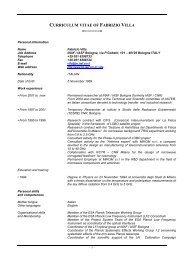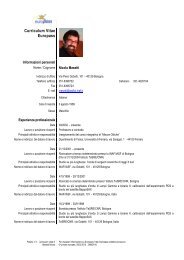Agatha Christie's Poirot Episode Guide - inaf iasf bologna
Agatha Christie's Poirot Episode Guide - inaf iasf bologna
Agatha Christie's Poirot Episode Guide - inaf iasf bologna
Create successful ePaper yourself
Turn your PDF publications into a flip-book with our unique Google optimized e-Paper software.
<strong>Agatha</strong> Christie’s <strong>Poirot</strong> <strong>Episode</strong> <strong>Guide</strong><br />
Barbara Franklin, the wife of Judith’s employer Dr Franklin and the childhood friend of Sir<br />
William Boyd Carrington, dies the following evening. She has been poisoned with physostigmine<br />
sulphate, an extract from the Calabar bean that her husband has been researching. After <strong>Poirot</strong>’s<br />
testimony at the inquest — that Mrs Franklin had been upset and that she had emerged from<br />
Dr Franklin’s laboratory with a small bottle — a verdict of suicide is brought in, but Hastings<br />
suspects that the death was murder and <strong>Poirot</strong> confirms this.<br />
Norton, still evidently upset about what he has seen through the binoculars, asks Hastings for<br />
his advice, which is to confide in <strong>Poirot</strong>. <strong>Poirot</strong> arranges a meeting between them and says that<br />
Norton must not speak to anyone further of what he has seen. That night, Hastings is awakened<br />
by a noise and sees Norton — with his dressing-gown, untidy grey hair and characteristic limp —<br />
go into his bedroom. The next morning, however, Norton is found dead in his locked room with<br />
a bullet-hole perfectly in the centre of his forehead, the key in his dressing-gown pocket and a<br />
pistol (remembered by a housemaid as belonging to him) nearby. Apparently, X has struck again.<br />
<strong>Poirot</strong> takes Hastings over the evidence, pointing out that his belief that he saw Norton that<br />
night relies on loose evidence: the dressing-gown, the hair, the limp. Nevertheless, it seems that<br />
there is no one in the house who could have impersonated Norton, who was a short man. Hastings<br />
despairs that the mystery will ever be solved when <strong>Poirot</strong> himself dies that night, apparently<br />
of natural causes. He nevertheless leaves Hastings three conscious clues: a copy of Othello, a<br />
copy of John Ferguson (a 1915 play by St. John Greer Ervine), and a note telling Hastings to<br />
speak to his permanent valet, George. In the weeks that follow the death of <strong>Poirot</strong>, Hastings is<br />
staggered to discover that Judith has all along been in love with Dr Franklin, and is now marrying<br />
him and going with him to do research in Africa. Was Judith the murderer? When Hastings<br />
speaks to George, he discovers that <strong>Poirot</strong> wore a wig, and that <strong>Poirot</strong>’s reasons for employing<br />
Curtiss were vague. Perhaps the murderer was Curtiss all along?<br />
The solution, and one of the greatest of Christie’s twist endings, is contained in a written<br />
confession that is sent to Hastings from <strong>Poirot</strong>’s lawyers, four months after <strong>Poirot</strong>’s death from<br />
a heart attack. <strong>Poirot</strong> reveals that he wore a false moustache as well as a wig and explains that<br />
X was Norton, a man who had perfected the technique of which Iago in Othello (like a character<br />
in Ervine’s play) is master: applying just such psychological pressure as is needed to provoke<br />
someone to commit murder, without his victim truly realising what is happening. Again and<br />
again Norton had demonstrated this ability, first by apparently clumsy remarks that goaded<br />
Colonel Luttrell to take a shot at his wife. The shot is not fatal and Mrs Luttrell recovers. Then,<br />
Norton carefully manipulated Hastings to resolve upon the murder of Major Allerton. It was<br />
Norton’s contrivances that created the impression to Hastings that Judith loved Allerton, when<br />
in fact she has been in love with Franklin all along. Hastings’s potential murder was averted by<br />
<strong>Poirot</strong>, who put sleeping pills in Hastings’ hot chocolate that night. <strong>Poirot</strong> knew Hastings was not<br />
a murderer, but had he not intervened Hastings likely would have hanged.<br />
Deprived of his prey twice, Norton turned to Mrs Franklin, fertile territory, as she was really<br />
a conniving and mercenary woman underneath her timid facade. Mrs Franklin was successfully<br />
manipulated by Norton to attempt the murder of her husband, after which she could be reunited<br />
with the wealthy Boyd Carrington. By an ironic twist of fate, Hastings himself had inadvertently<br />
intervened, by turning a revolving bookcase table while seeking out a book to solve a crossword<br />
clue (Othello again, coincidentally), thus accidentally swapping the cups of coffee and the one<br />
with poison in it was actually drunk by Mrs Franklin herself. <strong>Poirot</strong> knew all this but could<br />
not prove it and sensed that Norton, who had been deliberately vague about whom he had seen<br />
through the binoculars when attempting to imply that he had seen Allerton and Judith, was now<br />
intending to reveal that he had seen Franklin and Judith, thus almost certainly implicating them<br />
in the apparent murder of Mrs Franklin. The immediate solution was for <strong>Poirot</strong> to heavily insist<br />
that Mrs Franklin had actually done what she had meretriciously whined about doing — taking<br />
her own life — which no one ever believed she would do. <strong>Poirot</strong>’s strange insistence confuses<br />
Hastings, but the strength of <strong>Poirot</strong>’s word carries the day.<br />
However, the only permanent solution was for <strong>Poirot</strong> himself to murder Norton. At their meeting,<br />
he revealed to Norton what he suspected and said that he intended to ’execute’ him. He then<br />
gave him hot chocolate. Norton, who did not deny anything, remained arrogantly self-assured in<br />
the face of both the accusation and the threat, insisted on swapping cups, but both contained<br />
the same sleeping pills which <strong>Poirot</strong> had previously used to drug Hastings; guessing that Norton<br />
would request the swap, <strong>Poirot</strong> had drugged both cups, knowing that his time taking the pills<br />
192

















